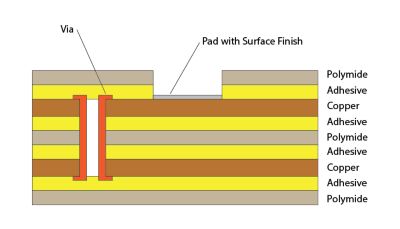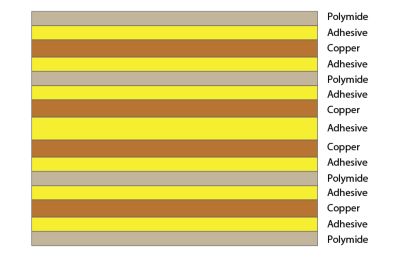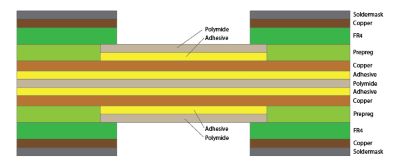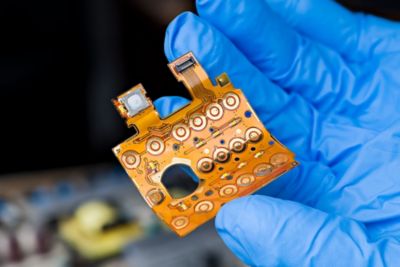INFORMATIONS SUR LE SUJET
Que sont les PCB flexibles, et comment sont-ils fabriqués ?
Les cartes de circuits imprimés flexibles (PCB) constituent un type d'interconnexion électronique qui gagne en popularité. Cette approche de connexion de composants dans un circuit offre des options de conception et une plus grande robustesse. Également appelés circuits électroniques flexibles, circuits imprimés flexibles (FPC) ou circuits flexibles, les chemins conducteurs du circuit sont construits sur un substrat en plastique flexible, généralement en polyimide, PEEK ou polyester, et les composants sont soudés sur des pastilles de cuivre exposées.
Les cartes de circuits imprimés flexibles peuvent comporter une, deux ou plusieurs couches de circuits conducteurs en cuivre. Grâce à sa flexibilité, le substrat présente des avantages par rapport aux PCB rigides dans le domaine de l'emballage.
Le marché des PCB flexibles a généré un revenu de 21,8 milliards de dollars en 2023, soit 30 % du marché de 73 milliards de dollars pour tous les types de PCB. Les circuits flexibles prennent en charge les mêmes composants électroniques que les cartes rigides, et comme cette technologie plus répandue, les processus de fabrication, les matériaux et l'emballage des assemblages électroniques influencent la configuration des cartes de circuits flexibles.
La différence réside dans la flexibilité du substrat. Les concepteurs doivent comprendre ces facteurs afin d'éviter les difficultés et de tirer parti des avantages de cette méthode (littéralement) flexible pour réaliser des conceptions de circuits.
Comprendre la structure des PCB flexibles
Les PCB flexibles sont construits à partir de couches de matériaux utilisés pour conduire, isoler ou lier. En fonction du nombre de couches conductrices, les FPC peuvent être divisés en types simple, double ou multicouche.
En plus de ces couches, d'autres caractéristiques importantes d'un PCB flexible sont les zones où la couche extérieure de matériau isolant est retirée pour exposer les pastilles de soudure et les trous plaqués cuivre, appelés vias, qui servent à assurer la conduction entre les couches.

Une configuration monocouche comprend un substrat diélectrique souple, une couche adhésive, une couche conductrice, une autre couche adhésive et une couche de couverture diélectrique souple.

Les configurations à double couche comportent une superposition d'adhésif, de conducteur, d'adhésif et de diélectrique des deux côtés du diélectrique de base. Des vias, sous forme de trous traversants plaqués, sont ajoutés pour relier les couches conductrices.

Dans les configurations multicouches, cette structure stratifiée est empilée avec le nombre de couches nécessaire, et les vias peuvent être réalisés en travers ou à l'aveugle.

Les PCB flexibles peuvent également être fixés aux PCB rigides en intégrant des couches à l'intérieur des PCB rigides. Cette configuration, appelée PCB rigide-flex, est souvent un moyen de profiter des avantages des deux formats en même temps ou de relier plusieurs PCB rigides avec un circuit flexible au lieu de câbles ou d'un faisceau de câblage.

Les avantages des PCB flexibles les rendent également particulièrement adaptés aux conceptions utilisant des interconnexions à haute densité (HDI). Les HDI permettent aux ingénieurs de créer des PCB rigides-flex avec des circuits plus compacts, des couches plus fines et des micro-vias, tout en intégrant une portion flexible dans la conception du PCB.
Le format plus réduit fait des HDI un excellent choix pour les applications avec des besoins d'emballage complexes ou compacts. L'emballage compact fait des PCB flexibles non seulement le choix privilégié pour offrir de plus grandes possibilités de conception, mais souvent le seul moyen de connecter des HDI à d'autres composants.
À l'inverse, lorsqu'une configuration exige une carte rigide pour un composant comme une puce ou un capteur délicat, ces composants peuvent être placés sur un HDI connecté à un FPC.
Vous trouverez ci-dessous une brève description des composants utilisés pour créer l'empilement d'un PCB flexible.
Couche diélectrique flexible
Il s'agit du matériau de base d'un PCB flexible. Il définit les propriétés physiques caractéristiques de l'assemblage, en particulier la forme et la rigidité de la structure finale. Le substrat est généralement en polyimide (PI) en raison de sa flexibilité, de sa résistance aux produits chimiques et de ses propriétés thermiques avantageuses.
Un autre matériau populaire est le polyester (PET), mais d'autres polymères diélectriques peuvent être utilisés lorsque des propriétés spécifiques sont nécessaires. L'épaisseur de cette couche est typiquement comprise entre 12 μm et 125 μm. Plus la couche est épaisse, plus la structure est rigide. Le substrat agit à la fois comme une couche centrale et une couche isolante, comme un masque de soudure sur un PCB rigide, au-dessus de la couche conductrice.
Couche adhésive de liaison
La structure de stratifié utilise une couche adhésive, car la couche conductrice ne se fixe pas directement à la couche de base. Les concepteurs doivent prêter attention à la résistance de liaison et à la température maximale du matériau adhésif, car ces valeurs limitent la charge mécanique et thermique.
Couche conductrice
La couche conductrice de l'empilement de stratifié est généralement en cuivre. Cependant, d'autres métaux conducteurs peuvent être utilisés si nécessaire. Dans la plupart des applications, la couche de cuivre est créée à partir d'une feuille qui est collée au substrat, puis gravée pour créer le circuit désiré. La feuille métallique peut également être disponible en différentes épaisseurs. La feuille de cuivre est généralement enroulée pour produire une feuille de cuivre laminé ou électrodéposé. Des encres conductrices peuvent également être utilisées pour imprimer les pistes.
Cuivre plaqué
Lorsque la conception nécessite une connexion entre les couches, des trous sont percés dans le stratifié et plaqués de cuivre pour créer des vias.
Finition de surface
L'inconvénient des métaux hautement conducteurs comme le cuivre est qu'ils s'oxydent facilement. Pour lutter contre ce phénomène, une fine couche de matériau est appliquée comme finition de surface. Ces matériaux facilitent également la soudure. Les types de finition de surface les plus courants sont l'or par immersion au nickel chimique (ENIG), l'agent organique conservateur de soudabilité (OSP), l'argent d'immersion, l'étain d'immersion et l'or.
Raidisseurs
Il arrive qu'une rigidité mécanique soit requise dans une zone du PCB flexible. Le raidisseur peut être un morceau de FR4, le matériau des PCB rigides ou une couche plus épaisse de polyimide. Un usage courant d'un raidisseur FR4 est de soutenir un connecteur rigide ou d'éviter que le circuit ne se plie sous un gros composant soudé, afin de réduire la tension sur la soudure.
Avantages des circuits imprimés flexibles
L'utilisation de PCB flexibles offre de nombreux avantages. Les propriétés mécaniques et thermiques du substrat ouvrent de multiples possibilités de conception et de performance. La plupart des avantages proviennent de la flexibilité des matériaux du circuit imprimé et de la possibilité de créer facilement des formes complexes grâce à la découpe laser. En outre, le matériau du substrat offre souvent de meilleures propriétés thermiques que les matériaux utilisés dans les PCB rigides. Les avantages les plus importants sont énumérés ci-dessous.
Utilisation efficace de l'espace
Les PCB flexibles sont plus fins, facilement découpables en formes complexes, et peuvent être pliés pour s'adapter à la forme de l'appareil dans lequel ils sont installés. En outre, notamment dans les circuits rigides-flex, il est possible de placer les composants dans diverses orientations tout en maintenant la connexion.

Un PCB flexible fabriqué
Robuste dans les environnements difficiles
Le matériau polymère utilisé dans les conceptions flexibles résiste aux produits chimiques agressifs. Il peut également résister à des températures élevées et offre de meilleures capacités de dissipation de chaleur que les PCB rigides.
Meilleure durabilité
Lorsqu'ils sont conçus correctement, les circuits flexibles peuvent supporter un grand nombre de cycles de flexion sans endommager le circuit conducteur.
Résistance aux chocs et aux vibrations
Une rigidité et une masse plus faibles entraînent une moindre quantité d'énergie entrant et se transmettant dans un assemblage électronique utilisant des PCB flexibles. Le matériau peut également survivre à des niveaux importants de contrainte causés par les chocs et les vibrations.
Réduction de la masse
Dans les applications où chaque gramme compte, les PCB flexibles offrent aux circuits électroniques une masse inférieure à celle des cartes rigides.
Assemblage simplifié
Lors du remplacement du câblage traditionnel ou des faisceaux de câblage, les PCB flexibles peuvent réduire considérablement les coûts d'assemblage. Ils n'ont pas besoin d'être fixés avec des vis ou des pinces, et peuvent être collés ou laissés détachés à l'intérieur d'un boîtier.
Défis des PCB flexibles
À première vue, il existe de nombreuses raisons d'utiliser des PCB flexibles ou rigides. Cependant, les circuits imprimés rigides standard restent la solution la plus utilisée pour les circuits électroniques, car de nombreuses applications ne bénéficient pas d'un substrat flexible. Voici un aperçu des défis les plus importants des PCB flexibles.
Coût
Les coûts de matériaux et de fabrication des PCB flexibles sont plus élevés que ceux des PCB rigides, omniprésents dans l'industrie. Ces coûts finiront par diminuer à mesure que les circuits flexibles deviendront plus populaires. Cependant, la difficulté de créer une superposition de matériaux flexibles et le prix du matériau de base maintiendront les coûts plus élevés.
Flexion sous les composants et flexion des pistes
Le plus grand avantage des PCB flexibles peut également être un inconvénient. La flexion du matériau sous un composant rigide peut exercer une pression importante sur la soudure reliant le composant à la couche conductrice. Les raidisseurs offrent une bonne solution à ce problème, mais leur ajout augmente les coûts.
La même flexion qui peut mettre à rude épreuve les joints de soudure peut également entraîner des défaillances dans les circuits conducteurs si le tracé des pistes ne prend pas en compte la concentration de contraintes. L'utilisation appropriée de la simulation de fiabilité électronique peut identifier les zones problématiques dans une conception et aider à piloter la conception de PCB pour éviter les défaillances dues à une flexion excessive.
Défis posés par la fabrication des PCB flexibles
Il est très facile d'automatiser la construction et l'assemblage d'une carte PCB rigide. Les circuits fins et flexibles sont plus difficiles à maintenir dans les tolérances de fabrication, et l'automatisation du placement et de la soudure des composants est plus complexe.
Problèmes d'intégrité des signaux
L'intégrité des signaux désigne la capacité d'un signal électrique à traverser un circuit sans dégradation ni distorsion. Le matériau fin utilisé dans les PCB flexibles peut générer des interférences électromagnétiques (EMI) entre les circuits. En outre, la flexion du substrat peut provoquer des changements dans la réflexion du signal et des décalages d'impédance. Ces défis peuvent être surmontés en suivant de bonnes pratiques de conception et un routage approprié guidé par la simulation de l'intégrité des signaux.
Applications courantes des PCB flexibles
Les PCB flexibles trouvent leur place dans une grande variété d'applications dans lesquelles les avantages de la technologie l'emportent sur le coût plus élevé, et une conception optimisée peut permettre d'éviter les défis.
L'application la plus fréquente des PCB flexibles concerne les appareils électroniques destinés aux consommateurs, où la forme et la taille exigent que le circuit s'adapte à la forme de l'appareil tout en réduisant au maximum sa taille. Des calculatrices aux téléphones portables, les concepteurs équilibrent performance et esthétique grâce à l'utilisation judicieuse d'un circuit électronique flexible.
Le remplacement de faisceaux de câblage onéreux par un PCB flexible résistant aux vibrations et à la chaleur, et qui peut s'adapter dans un espace réduit, rend cette technologie idéale pour de nombreuses applications dans le secteur automobile. Un autre atout pour les concepteurs automobiles est la possibilité de relier des composants qui ne se trouvent pas sur le même plan, grâce à des connecteurs positionnés à des angles atypiques. Ces avantages poussent également les concepteurs de capteurs industriels à adopter des PCB flexibles pour connecter les composants de manière optimale et résister à la chaleur et aux vibrations des machines industrielles qu'ils surveillent.
Les dispositifs médicaux, en particulier les dispositifs portables, reposent également sur des circuits imprimés flexibles. C'est une solution idéale pour gérer les contraintes de poids et de taille des dispositifs portables et leur besoin de s'adapter à la forme organique du corps humain. À mesure que les dispositifs médicaux deviennent plus petits et plus puissants, les entreprises choisiront des PCB flexibles ou rigides-flexibles.
L'avenir des PCB flexibles
De multiples tendances dans l'industrie électronique favorisent l'adoption accrue des PCB flexibles. L'effort continu pour obtenir de plus grandes performances dans des formats plus petits incitera les concepteurs à remplacer les PCB rigides et plats pour intégrer les circuits dans leurs dispositifs.
Les fournisseurs de technologie flexible travaillent sur de nouveaux matériaux pour offrir des performances améliorées. L'adoption accrue conduira également à une baisse des prix et à une production plus rapide à mesure que les fabricants déploieront de meilleurs processus de fabrication et davantage d'automatisation. De plus en plus de fournisseurs proposeront la fabrication de PCB flexibles, et les fabricants sous contrat augmenteront leur capacité à assembler des PCB flexibles dans des appareils.
L'essor des écrans flexibles et de l'électronique industrielle et grand public toujours plus petit contribuera à une adoption accrue de ces PCB flexibles. Cette technologie nécessite l'utilisation de circuits flexibles. De même, la demande pour des ordinateurs et des appareils mobiles plus performants, toujours plus fins, continuera de faire progresser la technologie. Enfin, l'électrification des automobiles nécessitera des circuits plus flexibles dans des environnements plus étroits et plus difficiles.
Pour concrétiser cet avenir, les ingénieurs devront concevoir des emballages avec des PCB flexibles et rigides-flexibles afin de concilier des caractéristiques souvent contradictoires. Utilisez la suite d'outils de simulation Ansys pour examiner les options de conception et parvenir à la solution optimale. Voici quelques-uns des outils Ansys les plus couramment utilisés pour prendre en charge les circuits imprimés flexibles :
- Ansys Maxwell® : La référence en matière de simulation électromagnétique basse fréquence. Les concepteurs de PCB et les ingénieurs en électronique grand public utilisent le logiciel Maxwell pour résoudre des problèmes tels que les vibrations mécaniques induites électromagnétiquement et les interférences EMI/EMC par couplage inductif.
- Ansys HFSS™ : La référence en matière de simulation électromagnétique haute fréquence. Les ingénieurs utilisent le logiciel HFSS pour concevoir des dispositions de circuits et des antennes performantes et économiques, intégrées sur des PCB flexibles.
- Ansys SIwave™ : Spécialement dédié à la simulation électromagnétique des PCB, le logiciel SIwave fournit aux utilisateurs un moyen rapide et performant pour importer la géométrie et modéliser l'intégrité des signaux (SI), l'intégrité énergétique (PI), les interférences électromagnétiques (EMI), l'impédance et la diaphonie.
- Ansys Icepak® : La référence de l'industrie en matière de simulation thermique des PCB et de conception de systèmes de refroidissement. Ce logiciel inclut les meilleurs solveurs multiphysiques dans une interface utilisateur spécialement conçue pour la simulation des PCB.
- Ansys Sherlock™ : Sherlock permet d'importer différents formats de fichiers de PCB flexibles et offre plusieurs options pour prétraiter les fichiers, notamment pour les matériaux, la géométrie, les informations sur les pièces, etc. Un scénario typique consiste à exporter un fichier de PCB flexible modifié depuis Sherlock vers le logiciel Ansys Mechanical™ pour une analyse thermomécanique détaillée.
- Ansys Mechanical : Le logiciel Mechanical, associé à l'outil Sherlock, fournit une solution robuste pour analyser la fiabilité et les aspects thermomécaniques des PCB flexibles.
La raison pour laquelle tant de conceptions de PCB flexibles les plus complexes sont pilotées par la simulation Ansys est simple : les outils sont faciles à utiliser, s'intègrent parfaitement et fournissent des informations plus concrètes. Explorez les liens dans cet article ou contactez-nous pour nous faire part de vos besoins et de vos défis, et nos ingénieurs vous aideront à trouver la bonne solution.










